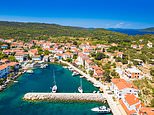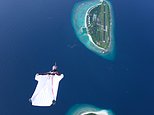
You meet people who say Croatia is the new Italy. It used to be a part of the Venetian Republic, so there is logic here.
And Diocletian’s Palace in Split is one of the greatest Roman monuments. There are suggestions of Italy everywhere. You find spageti bolonjeze on menus and it’s not too hard to fathom the Italian influence there. But you also find Hrskava riblji zalogaji (Croatian crunchy fishbites), which reminds you how satisfyingly foreign this country is.
Croatia may be the least known, certainly the least understood, country in Europe. As a result, in just two hours from London, it offers an escape sensation that is exciting and profound. The more so if you visit nearly secret islands. And even more so if you find unusually comfortable places to stay when you get there.
Mainland Dubrovnik may be Croatia’s gift to package trippers, but a few days on the islands of Hvar or Dugi Otok are an experience of terra incognita.
Judith Schalansky’s surprise bestseller, Pocket Atlas Of Remote Islands, proved the popular appeal of quiet and isolation in our busy world. Magic counts for a lot. Hvar and Dugi Otok have it.
Island life: ‘A few days on the islands of Hvar or Dugi Otok are an experience of terra incognita,’ writes Stephen Bayley. Above is the port of Sali on Dugi Otok
Croatia achieved independence only in 1991, after several millennia of battles, invasions, compromises and miscellaneous predations from Greeks, Ottomans, Corsairs and, lately, Serbs.
It is now a country that belongs to the EU but it includes less precise, almost mythic, territories including Istria and Illyria (which features in Shakespeare’s Twelfth Night, although it is unlikely he ever visited). Or Dalmatia: my destination. Dalmatia is a vanished kingdom like Litva, Sabaudia, Tsernagora and Etruria. Thus, doubly romantic. And it’s still there.
The plane to Split, a fine modern airport with unusual efficiency, begins its descent near Venice. This reminds you how close Italy is, at least geographically speaking.
Ancona to the west is just 180 miles away. But Italy’s Adriatic coast comprises fine, long beaches while Croatia’s is an astonishing spectacle of rugged islands. Seen from the plane, an endless necklace of brown and green in all sizes is strung across a vividly blue sea.
Once, these islands were tips of mountains because in Flintstone days you could walk from Croatia to Italy without getting your felt-bound feet wet.
The sight lets the mind wander to the lyrical and whimsical: Prospero’s island in Shakespeare’s The Tempest, William Golding’s Lord Of The Flies, H.G. Wells’ The Island Of Dr Moreau, Daniel Defoe’s Robinson Crusoe. They could all be here.
The precise number of islands is a matter of pride and competitive bragging. Of course, it all depends on what you mean by ‘island’. Accordingly, estimates differ wildly but, in pursuit of clarity, I got advice from the cartographic department of the UK Hydrographic Office. The answer is: any landform surrounded by water with an area greater than a square kilometre is an island.
If it’s less than a tenth of a square kilometre, what you are seeing is merely a rock. By this method, Croatia has 1,246 islands.
Stephen writes: ‘Judith Schalansky’s surprise bestseller, Pocket Atlas Of Remote Islands, proved the popular appeal of quiet and isolation in our busy world. Magic counts for a lot. Hvar [above] and Dugi Otok have it’
Hvar (above right and left) is one of 1,246 islands in Croatia – and is one of the biggest
Hvar is one of the biggest and was one of the Ancients’ Isles of The Blessed. The eponymous capital is now a notorious party town, a reinvention which began when Edward VIII and Wallis Simpson visited.
Its status as a venue for royal renegades was confirmed when Prince Harry was photographed jumping into a nightclub’s pool in 2011. There was a tradition of hoteliers giving the money back if the weather was bad though I think Harry and the boys may have put an end to that nice gesture.
However, my destination is on the other side of Hvar island, somewhere much less visited than Harry’s town, nightclub-free and reached from Split by the hotel’s launch, driven by impossibly handsome, tanned young men in startling whites who serve champagne as we clatter over a roiling, navy blue sea whose consistency looks like oil.
Stari Grad Na Hvaru, the Old Town of Hvar, the Pharos of the Greeks, is where you disembark. It looks as if communist stage designers had been briefed to replicate Portofino. There’s a pretty old town, but prettiness cannot eliminate an undertow of Balkan darkness, even menace.
Saturday morning, feckless boys in the Hemingway Bar do glum Djokovic impressions. A nasty-looking communist-era supermarket threatens. In ample compensation, there is a distinctive strain of Croatian woman as handsome as the boys on the boat: tall, slim, high cheekbones and open-faced with superb posture.
Maslina Resort, a project by a French financier, is on a perfect bay a few moments out of Stari Grad. It is very much a ‘concept’, designed by local architect Tomislav Alujevic. His concept is that accommodation is in ‘scattered pavilions’ while services are buried underground.
These pavilions are, essentially, concrete boxes but integrate nicely into the astonishingly green landscape because they are surrounded by timber slats which muddle light and shade and disguise the brutal structure. As a reminder of the forces of nature, the reception desk is a 14-ton cyclopean lump of stone from the neighbouring island of Brac.
Maslina offers guests wobbly wooden bikes and quotes from Thoreau on the theme of isolation on room keys. The elegant and friendly staff are in chic uniforms and are always willing to engage.
Bozava, which over-enthusiastic tourist authorities describe as a yachting haven, says Stephen, who adds: ‘”Haven’ is too lively a word to describe its unreal quietness’
Maslina Resort (above), a project by a French financier, is on ‘a perfect bay a few moments out of Stari Grad’
Grilled squid – a delicacy in Croatia
At Maslina Resort they like to say ‘time stands still’. Certainly, the isolation is superb. But that word ‘resort’ is a warning: something ambitious is planned here. ‘Residences’ are coming soon, witness the cranes.
The pioneering travel writer Norman Lewis lived on the Costa Brava in 1948 and, remembered the changes he witnessed in Voices Of The Old Sea (1984). The first developers arrived from Barcelona and a process began where fishermen’s wives become chambermaids in high-rise hotels. An invasion of money destroyed the sanctity that made the area popular. Let’s hope that doesn’t happen here.
To reach Dugi Otok, we returned to Split by a lumbering and tired ferry, a theatre of bad-tempered diesel harmonics, then drove to Zadar, via Sibenik, names that would not be out-of-place in Ruritania.
Lunch en route was at Maskovica Han in Pakostane, a fine place to savour Dalmatia’s collision of cultures. Winston Churchill said the Balkans ‘produce more history than they can consume’. Han was a holiday home fortress built in 1644 by a high dignitary of the sultan’s court who had a side hustle as an admiral of the Turkish fleet.
Perhaps the western-most Ottoman building, it has been meticulously restored and converted into a deluxe, if somewhat austere, hotel. Blasphemously, the mosque is a restaurant where I ate an excellent pasta with tomato sauce and shredded lamb sausage, drinking a fine white made of Posip, a local grape. The best Croatian wines are very good but production is so small, almost none are exported.
From Zadar, an empty catamaran took us to Bozava, which over-enthusiastic tourist authorities describe as a yachting haven. ‘Haven’ is too lively a word to describe its unreal quietness.
Dugi Otok means Long Island and if there are police, they are not obvious and road manners are freeform. Half an hour from Bozava, there is Villa Nai 3.3, so-called because in this mild climate there are usually no more than 3.3 days of snow a year. In the well-informed 1968 Companion Guide To Jugoslavia by J.A. Cuddon, Dugi Otok is not even mentioned.
Villa Nai is not so much built into the landscape as constructed out of it. Spoil from the excavations is the structural substance of its eight rooms, each with private access to a saltwater infinity pool.
It is the personal project of Goran Mucovic, a prosperous civil engineer who has now become an olive oil evangelist. There are olive trees as far as you can see in every direction, except the direction that points to the startlingly blue sea. The structure of polyphenols, Mucovic explained in his olive mill, is identical to ibuprofen. His oil wins international awards.
In the best possible way, there is nothing to do. So you get on Tomas’s boat for a trip around the Kornati Islands. These are inland waters but lively even in good weather.
After an infinity of archipelago, the skipper, muscular in shades, turns into the tiny harbour of Vrulje. Never have I been anywhere so remote. Accessible only by donkey or boat, the little village is a primal experience. There was just the gentle putt-putt of the rubbish collector’s boat, the snuffling of a dog constrained (from I don’t know what) by baler twine. Silence. Sea.
A long, battering speedboat ride returning to Zadar gave an opportunity to reflect. Villa Nai 3.3 could not be bettered for isolation, relaxed sophistication and a credible eco philosophy. It is in its way perfect, but be warned that perfection can be boring. Especially in bad weather.
Croatian mainlanders call the island folk boduli, a word suggestive of their primitivism which, of course, is exactly what visitors are seeking. This, despite Dalmatian prosciutto, is not the new Italy, it is the old Croatia. Therefore, marvellous and strange. It is not primitive, it is unspoilt, which is not quite the same thing.
But will an invasion of money make these islands better or worse? There’s a fine line, easily crossed, between development and ruination. As the Dalmatian boduli look at a future of high-value tourism while wanting to retain the quiet mystery of their fabled past, some absurdities arise.
On a building site at Villa Nai 3.3, spoil was being conscientiously re-used to create a helipad. It seemed rude to ask if it was an organic helipad.
It’s so fascinating weighing the evidence about the future of Hvar and Dugi Otok, I’m in no hurry to make a judgment.
But go now. Secret Dalmatia might not be a secret for much longer.
TRAVEL FACTS
Red Savannah (01242 787800, redsavannah.com) offers a stay in Croatia from £3,275 per person based on two adults staying one night at the Judita Palace Heritage Hotel in Split, three nights at Maslina Resort and three nights at Villa Nai 3.3 with a walking tour in Split. Includes breakfast, private transfers, return ferry journeys from Split to Hvar and Dugi Otok and return economy flights from London to Split with easyJet including bags and seating. For more information, visit maslinaresort.com; maskovicahan.hr; villanai.com.
Watch a video of Hvar’s Maslina Resort on The Mail+ – subscribe at mailsubs.co.uk.
Source link
CHECK OUT: Top Travel Destinations
READ MORE: Travel News



